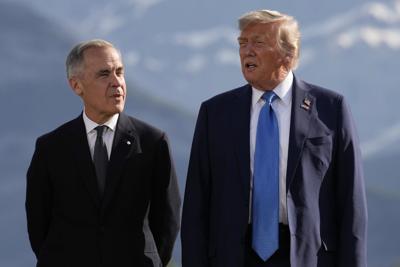ŌĆ£The worst thing you can do in a deal is seem desperate to make it.ŌĆØ
Donald Trump may have written that bit of wisdom, in his 1987 book ŌĆ£The Art of the Deal,ŌĆØ but heŌĆÖs not practising it. Ever since his administration vowed ŌĆ£90 deals in 90 days,ŌĆØ the president has been scrambling to ink trade deals before the full cost of his inflationary tariffs hit.
Luckily for Trump, the other parties have been even more desperate than him: Europe, South Korea, Japan have all inked bad deals with the unpredictable president.
Now that we can plainly see the miserable terms Trump has to offer, Canada needs to steel its resolve and get ready to say ŌĆ£no deal.ŌĆØ
Just look at where other countries have ended up. The United Kingdom thought it would gain an advantage by being the first to sign, acquiescing to 10 per cent across-the-board tariffs and a quota on its automobile exports. The Europe UnionŌĆÖs agreement, , was even worse, imposing a 15 per cent tariff rate and a requirement that it buy USD $250 billion in American energy products per year.
As for Japan and South Korea, they negotiated tariff rates ranging from 15 to , but were also expected to cough up huge sums of direct investment ŌĆö USD $550 billion from Tokyo and USD $350 billion from Seoul. Trump claimed that the deal requires 90 per cent of the profit of that investment remain in America and said he would personally direct the capital.
TrumpŌĆÖs shakedown was effective. French President Emmanuel Macron conceded as much when he declared last month that ŌĆ£to be free, you need to be feared. We were not feared enough.ŌĆØ Instead, they feared being left out ŌĆö but as Trump himself wrote, showing fear ŌĆ£makes the other guy smell blood, and then youŌĆÖre dead.ŌĆØ
But inherent in these deals is a recognition that these trade wars are costly and damaging: ThatŌĆÖs why Trump had to push his trading partners for billions in outlandish bribes.
The EUŌĆÖs proposed energy purchases are , and would require the bloc to triple its American oil and gas imports next year. Tokyo, meanwhile, says the proposed half-trillion dollar investment fund is more of an than a promise.
In truth, these goodies are really flashy theatrics intended to placate emperor Trump. That is an unbelievably naive gamble. If there is one thing Trump hates, itŌĆÖs being cheated. Even the perception of deception is enough to spark an economy-wrecking tantrum, as Canada has seen repeatedly.
Countries signed these loser deals because they offer the illusion of stability. But Trump doesnŌĆÖt want stability. When he lacks leverage, he creates it by knocking his opponent off-balance. In TrumpŌĆÖs gangster economics, you never shake down a mark just once: You keep coming back.╠²
These deals ŌĆö a hodgepodge of preliminary, half-compete, and framework agreements ŌĆö offer no guarantees. JapanŌĆÖs deal wasnŌĆÖt even ╠²
Worse still, underneath the shaky foundation of these Potemkin agreements is an even more rotten core: They are all built on one-way tariffs. The rates may be lower than TrumpŌĆÖs initial threat, but they are still much higher than zero. If Trump ever leaves office, why would his successor ever agree to drop those tariffs without more concessions?
We should deny Trump, and America, this long-term leverage. We need to draw the line in the sand: No tariffs, or no deal.
To stand firm, we need strength, which in turn comes from solidarity. Prime Minister Mark CarneyŌĆÖs critics need to stop creating the expectation that a good deal is likely or even possible, as Conservative Leader Pierre Poilievre did this week when he hectored Carney for not already getting a tariff-free agreement signed.
That same advice can go for Carney himself. At the G7, he set a 30 day deadline to ŌĆ£pursue negotiations toward a dealŌĆØ ŌĆö which many took for a deadline to end the trade war itself. Over that month, Carney even nixed our Digital Services Tax to keep talks on track (a strategic retreat, but a retreat nonetheless.) In recent days, he has continued signalling that success could be on the horizon.
On the campaign trail, Carney frequently told Canadians that he would prefer no deal over a bad deal. ItŌĆÖs clear now that there are only bad deals on offer. ItŌĆÖs time he dropped the optimistic tone.
Signing on AmericaŌĆÖs terms will mean dropping our retaliatory tariffs and plowing billions into a Trumpian slush fund. Instead, letŌĆÖs use those billions to harden our defences. We can and should buy up steel and lumber to build ships and homes; compensate sectors hard-hit; build new trade infrastructure to extend our economic reach elsewhere; and help small businesses manage the regulatory complexity brought on by this trade chaos. Carney has talked a good game about all of these things, and now is the time to turn more focus towards them.
The fact is, we donŌĆÖt need a deal because we already have a deal: As the mad president hikes tolls on the bridge, we still have a tunnel. Under CUSMA, of our exports to the United States are tariff-exempt. Some of Trump tariffs may still hit that protected trade, but that doesnŌĆÖt mean we should help him weaken it.
Another useful axiom from TrumpŌĆÖs book: ŌĆ£Protect the downside and the upside with take care of itself.ŌĆØ
Trump has been so able to bully those other countries because, with the exception of South Korea, it doesnŌĆÖt have free trade agreements with them. But we have a legally-binding agreement: CUSMA. Signing a deal with Trump today which tolerates tariffs, even at just 10 per cent, could weaken CUSMA in both the short and long term.╠²
If we codify tariffs, be it in CUSMA or some side deal, they are likely to outlive TrumpŌĆÖs time in office. Whenever sanity returns ŌĆö be it in three years or 30 ŌĆö we want to be the country that has never agreed to this economic blackmail.
If we expect to resist that outcome, we will need solidarity with our third partner, Mexico.╠²
This week, Finance Minister Fran├¦ois-Philippe Champagne and Foreign Affairs Minister Anita Anand were in Mexico to do exactly that. ŌĆ£We have been neighbours,ŌĆØ Champagne told reporters from Mexico City, ŌĆ£but we need to get to know each other a bit better.ŌĆØ
All three parties to CUSMA are due to review the deal on July 1 next year. Anand says ŌĆ£momentum has been buildingŌĆØ to get on the same page ahead of the CUSMA review, and it began with President Claudia SheinbaumŌĆÖs visit to Canada during the G7 summit last month. ThatŌĆÖs encouraging.
Together, Canada and Mexico can exert massive leverage on America. Despite his bluster, he knows he canŌĆÖt afford a prolonged North American trade war on two fronts.
Gaming out this scenario, Trump is likely to do what he always does: Threaten to quit.╠²
Under the CUSMA agreement, any party can leave the agreement six months after they first announce their intention to do so. That means America could exit the deal as soon as early 2027. Fine, let him.
We will never gain advantage by playing into the delusion that TrumpŌĆÖs beggar-thy-neighbour tactics are good economics. They are not. These deals are bad, and they are being made by a fundamentally unreliable man who wants to finance his illiberal incompetence with other peoplesŌĆÖ money.
After all, there is one more lesson from ŌĆ£The Art of the DealŌĆØ ŌĆö not from Trump, but from the guy who actually wrote it: The bookŌĆÖs co-author, Tony Schwartz. He gained valuable insights into TrumpŌĆÖs mind in the process. ŌĆ£He lied strategically. He had a complete lack of conscience about it,ŌĆØ Schwartz told the in 2016. Lying, Trump believed, ŌĆ£gave him a strange advantage.ŌĆØ╠²
Our allies will soon find out exactly how much a deal is worth with the liar-in-chief. Canada would do well to avoid the game altogether.
Error! Sorry, there was an error processing your request.
There was a problem with the recaptcha. Please try again.
You may unsubscribe at any time. By signing up, you agree to our and . This site is protected by reCAPTCHA and the Google and apply.
Want more of the latest from us? Sign up for more at our newsletter page.























To join the conversation set a first and last name in your user profile.
Sign in or register for free to join the Conversation